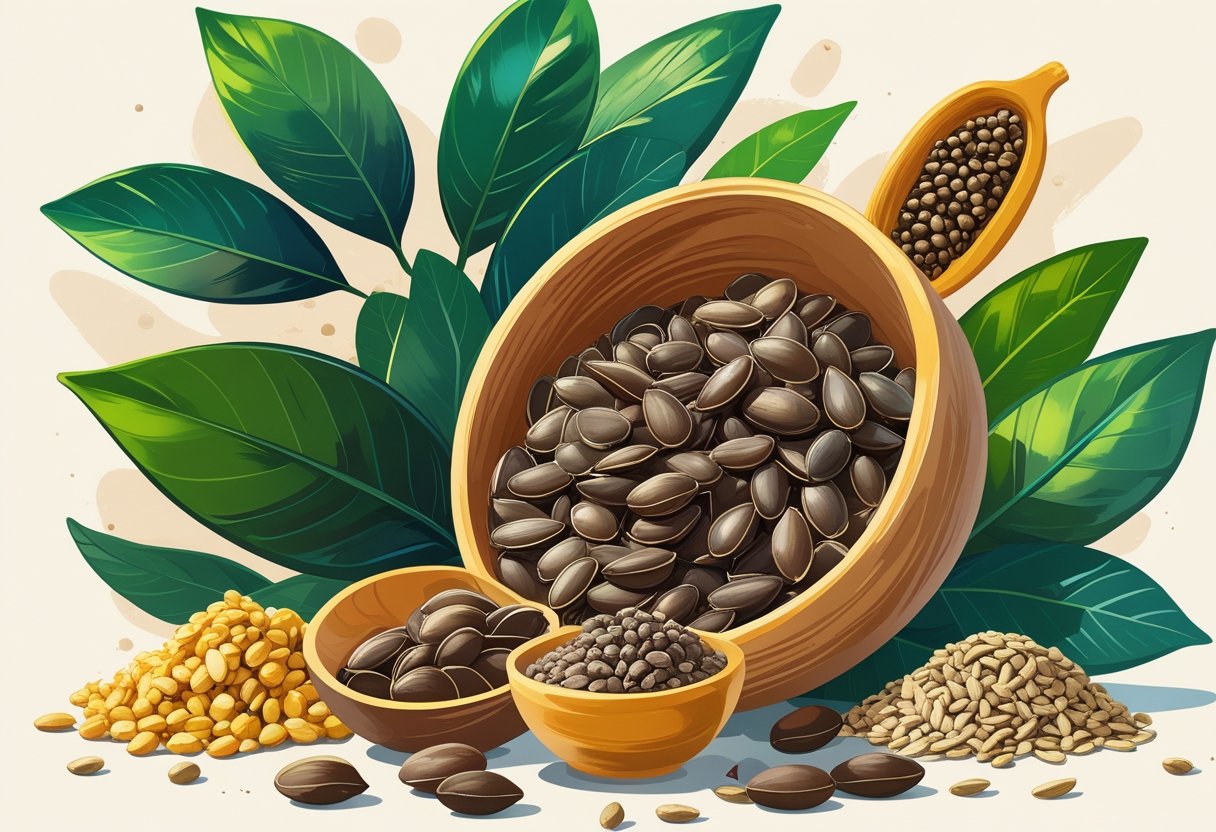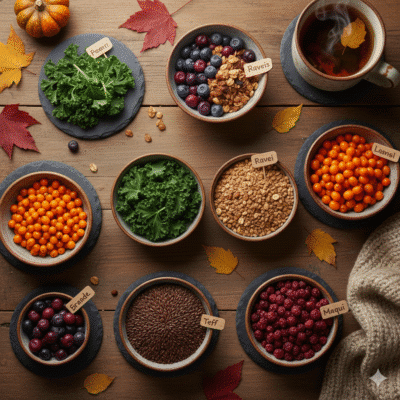Most folks reach for the usual superfoods—blueberries, quinoa, kale—when they want to eat better or feel healthier. But honestly, there’s a whole world of nutrient-packed foods out there that rarely get any attention, and some of them are pretty incredible.
Trying out lesser-known superfoods can shake up your meals and deliver nutrients you might be missing. From ancient grains to fruits with names you’ve probably never heard before, there’s a lot to discover. Figuring out how to spot and use these foods is a great way to mix things up and get more out of what you eat.
1) Moringa Leaves

Moringa oleifera leaves grow on a tree that’s native to India. These little green leaves are surprisingly packed with nutrients in a small package.
They’re loaded with vitamins A, C, and E, and you get a good dose of calcium, potassium, and iron too.
Fresh moringa leaves can be cooked like spinach, but honestly, most people just use dried moringa powder in smoothies or sprinkle it on food.
When you dry and grind the leaves, you end up with a powder that’s even more nutrient-dense than the fresh stuff.
It’s easy to toss moringa powder into a smoothie, soup, or even steep it as a tea. The flowers work for tea, too, if you’re feeling adventurous.
Moringa’s antioxidants help protect your cells from damage. That’s the kind of thing you want on your side, right?
This plant grows in all sorts of places and doesn’t need much water, which is why it’s often used in nutrition programs for areas where food options are limited.
For some reason, moringa hasn’t caught on like kale or quinoa. But interest is growing—maybe it’s just a matter of time before it’s everywhere.
2) Sacha Inchi Seeds

Sacha inchi seeds come from a plant in the Peruvian highlands. They’re sometimes called Inca peanuts (though they’re not actually peanuts, weirdly enough).
These seeds have all the essential amino acids—so, a complete protein. They’re especially rich in branched-chain amino acids, which people say are good for muscles.
But here’s the kicker: sacha inchi seeds are one of the best plant sources of omega-3s. You also get omega-6 and omega-9, and the balance is pretty solid.
Most folks eat them roasted as a snack, but you can also find sacha inchi powder or oil for cooking and supplements.
If you’re an athlete or vegetarian, you might find these especially handy for protein and sustainable energy.
Some research points to the omega-3s being good for your heart and brain. The fiber in the seeds helps with digestion and makes you feel full, too.
Not many people have heard of sacha inchi yet, but they’re popping up in more health stores and online these days.
3) Teff Grain
Teff is a tiny, ancient grain from Ethiopia that’s finally getting some attention. Technically, it’s a starchy seed, but it acts a lot like a whole grain in your diet.
Teff brings a lot to the table: calcium, iron, magnesium, selenium, zinc, and vitamin B6—all in notable amounts.
Compared to brown rice, teff has 50% more protein and five times the fiber. And get this—it’s got 25 times more calcium than brown rice.
Stacked up against quinoa, teff has half the fat and almost double the iron. Plus, it’s got more calcium and manganese, and less sugar.
It’s high in resistant starch, which can be good for blood sugar and digestion. Some even say it helps with weight control.
Teff is also pretty easy on the environment. Its sustainability makes it a favorite for eco-minded eaters.
You can grind teff into flour or cook the whole grain. The flavor’s mild and nutty, so it fits in just about anywhere—think porridge, bread, or pancakes.
4) Rambutan Fruit
Rambutan is a tropical fruit from Southeast Asia that looks like a little red sea creature, thanks to its spiky, hairy shell.
Crack it open and you’ll find juicy, translucent flesh with a sweet, floral flavor—kind of like lychee, but with its own twist.
It’s a great source of vitamin C, so it’s helpful for your immune system. Just a handful gives you a solid boost.
Rambutan has natural antioxidants, which help fend off cell damage from daily life. That’s always a plus.
It’s also super hydrating, mostly water, and has a bit of fiber for digestion.
Despite all that, rambutan’s still pretty rare in Western grocery stores. Most people outside Southeast Asia haven’t even seen one.
The fruit’s natural sweetness makes it a fun, healthy snack. You can eat it fresh or toss it into desserts or salads if you’re feeling creative.
If you want to try rambutan, check out Asian markets—just know it’s only around during certain seasons.
5) Black Garlic
Black garlic starts out as regular garlic, but after fermentation, it turns sweet, savory, and a little sticky—nothing like the sharp bite of raw garlic.
Fermentation creates melanoidins, which give black garlic its antioxidant and anti-inflammatory punch. In fact, it’s got about twice the antioxidant power of regular garlic.
This fermented superfood might help your heart and protect your cells. Some studies say it could regulate appetite and support metabolism, probably thanks to its fiber.
People have used black garlic in Asian cooking and medicine for ages. It doesn’t leave you with garlic breath, either, so that’s a win.
Fermentation concentrates nutrients and adds new ones, making them easier for your body to use.
Add black garlic to recipes or eat it as a supplement. The sweet, complex flavor fits in everything from sauces to spreads—without the harshness of raw garlic.
Understanding Superfoods
The word “superfood” gets thrown around for foods that are especially rich in nutrients, although there’s no official scientific definition. Researchers keep finding new ones by digging into nutritional data and looking at what people eat around the world.
Defining Superfoods in Modern Nutrition
Superfoods are just foods with unusually high levels of vitamins, minerals, antioxidants, or other good stuff. They usually pack several nutrients that work together to support your health.
The category is pretty broad. Ancient grains give you carbs and protein. Seeds and nuts are loaded with healthy fats and minerals. Leafy greens bring vitamins and plant nutrients.
What really sets superfoods apart is their nutrient density—they’ve got more good stuff per bite compared to everyday foods.
The term started out as marketing, but there’s now a fair bit of research showing that some of these foods really do have above-average nutrition.
Key characteristics include:
- High antioxidant content
- Multiple essential nutrients
- Bioactive compounds
- Low calorie-to-nutrient ratios
How Lesser-Known Superfoods Are Discovered
Scientists find new superfoods by testing foods for nutrients and studying traditional diets. Labs measure things like antioxidant levels, vitamins, and rare compounds.
Looking at what people eat in places known for longevity or good health can be a goldmine for new superfood ideas.
Discovery methods include:
- Phytochemical analysis
- Traditional medicine studies
- Population health research
- Agricultural biodiversity surveys
Food science labs use advanced tools to figure out just how much nutrition is in a food and how well your body can use it.
Many of these up-and-coming superfoods come from far-off places or are ancient versions of crops we already know. Hemp seeds and tempeh are good examples of foods that have moved up the ranks thanks to research.
Incorporating New Superfoods Into Your Diet
Adding new superfoods to your meals doesn’t have to be complicated. Start small, mix them in with things you already like, and see what happens.
Simple Ways to Add Uncommon Superfoods to Meals
Smoothies and drinks are probably the easiest way in. Toss some baobab powder into your morning smoothie, or try a bit of spirulina in a green juice. Fruits usually cover up any weird flavors from new superfoods.
Powdered forms are handy, too. Cacao nibs go great in oatmeal or yogurt. Maca powder mixes right into pancakes or energy bites.
Substitute in familiar dishes. Use amaranth instead of your usual grains in a salad, or sprinkle hemp hearts over a bowl of greens.
| Superfood | Simple Addition Method | Serving Size |
|---|---|---|
| Baobab powder | Mix into smoothies | 1 teaspoon |
| Spirulina | Blend in green drinks | ½ teaspoon |
| Cacao nibs | Sprinkle on yogurt | 1 tablespoon |
| Hemp hearts | Add to cereals | 2 tablespoons |
Start with small amounts—just half a serving or less at first. Give your taste buds a little time to catch up, and you’ll probably find a few new favorites.
Potential Benefits and Considerations
Digestive adjustment periods happen pretty often when you start eating more fiber-rich superfoods. You might notice some mild bloating or changes in your bathroom habits for the first few days—honestly, that’s normal and usually fades after a week or so.
Quality sourcing really matters for both safety and nutrition. Organic certification cuts down on pesticides, and third-party testing helps confirm powdered superfoods are actually pure.
Medication interactions can be a real concern, so it’s smart to talk with your doctor before adding new superfoods, especially if you’re taking something like blood thinners. Spirulina, for example, might mess with blood clotting. If you’re on prescriptions, a quick chat with your healthcare provider is just common sense.
Cost considerations can sneak up on you, too. If you use these regularly, buying in bulk saves money. Frozen versions usually cost less than fresh exotic stuff. Sometimes local health food stores have bulk bins with surprisingly good prices—worth checking out.
Storage requirements shift a lot depending on the superfood. Powders do best in airtight containers somewhere cool and dry. Fresh ones? They need the right fridge temps to keep their nutrients intact. It’s not rocket science, but it’s easy to overlook.




